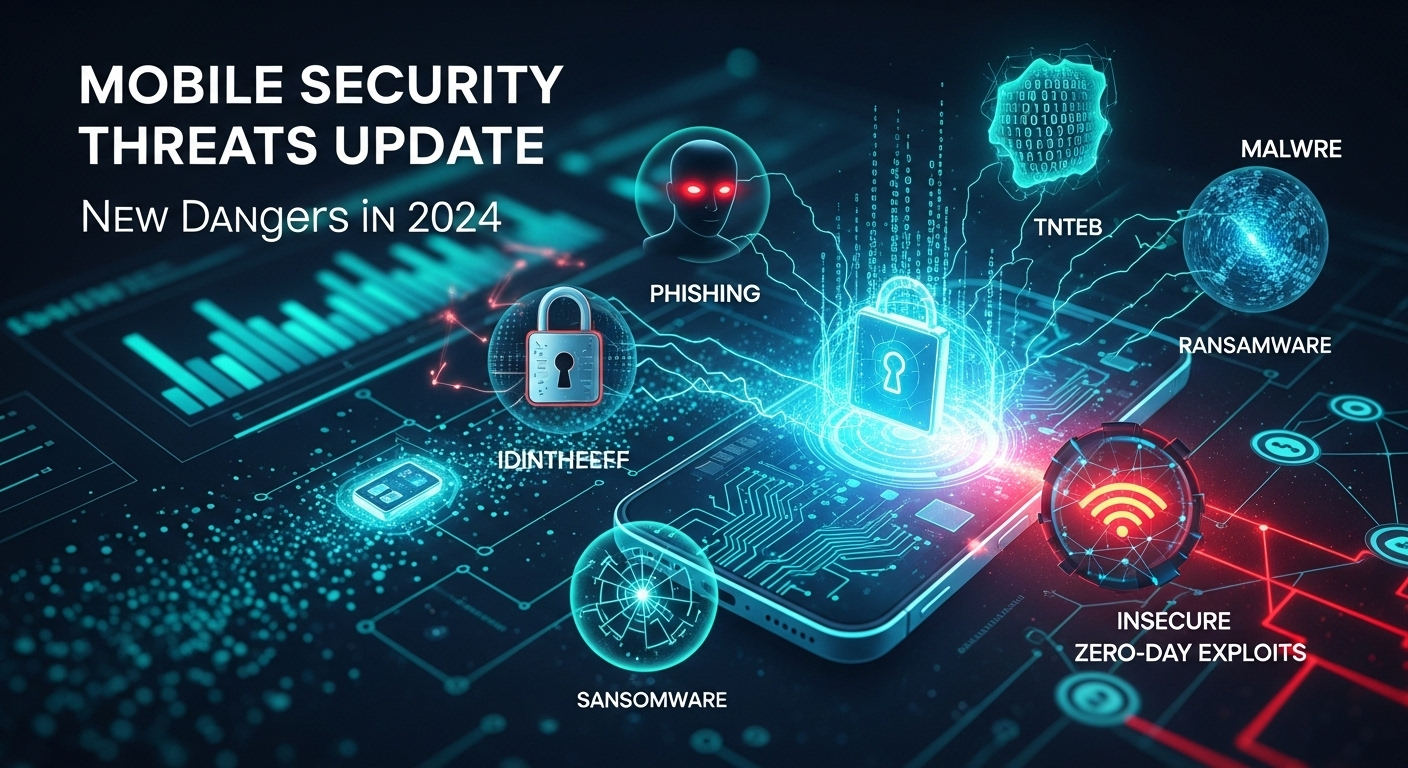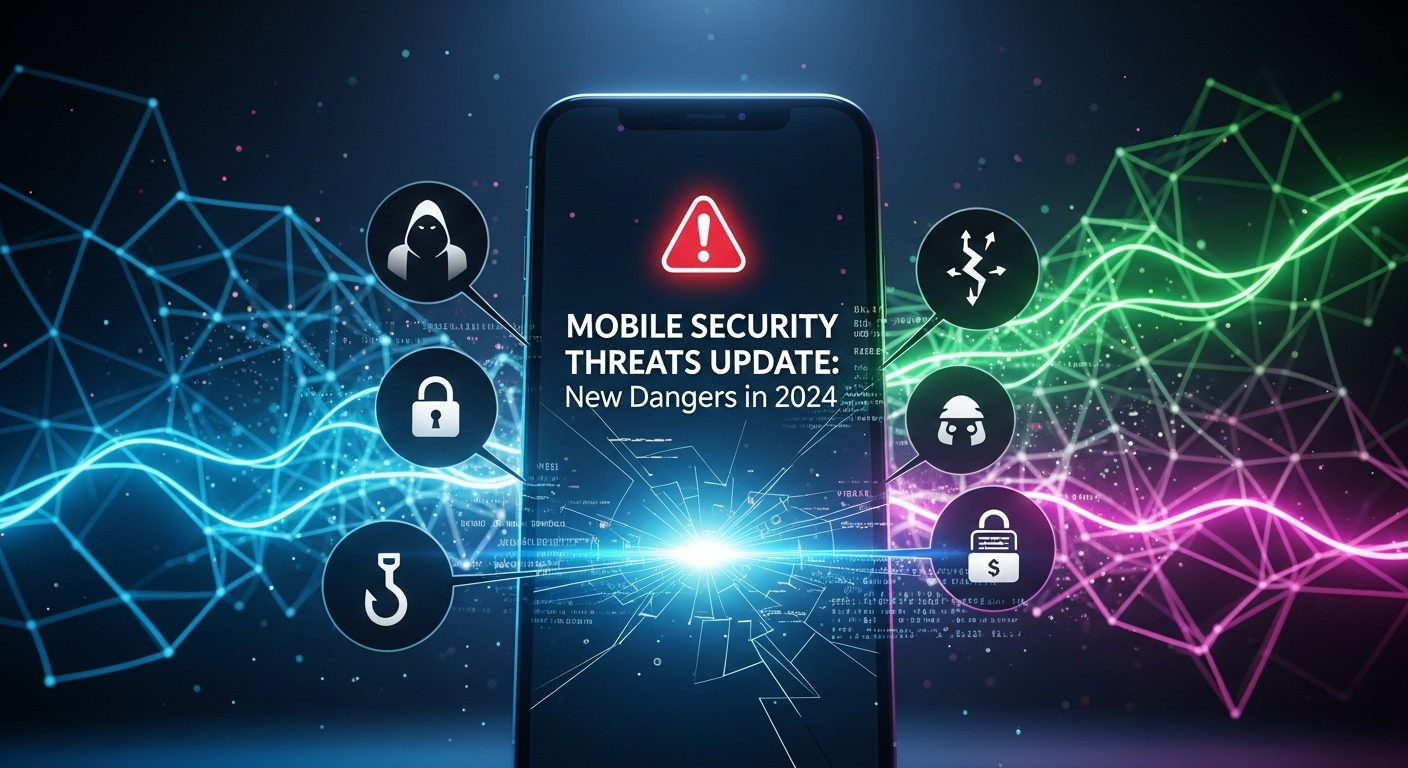Your smartphone is no longer just a device for calls and texts; it's your bank, your office, your photo album, and your primary window to the digital world. This deep integration into our daily lives makes it an incredibly valuable target for cybercriminals. As technology evolves, so do the tactics of those who wish to exploit it. Staying informed is not just a good idea—it is a necessity. This comprehensive mobile security threats update will guide you through the new dangers emerging in 2024, providing the knowledge you need to protect your most personal device. The threats are more sophisticated than ever, leveraging artificial intelligence, social engineering, and complex delivery mechanisms to bypass traditional defenses.
Table of Contents
ToggleThe Evolving Landscape of Mobile Malware
The concept of mobile malware is not new, but its evolution in recent years has been staggering. Gone are the days of simple, annoying adware. Today's mobile malware is a sophisticated tool designed for stealth, persistence, and maximum financial gain. Attackers have shifted their focus from widespread, noisy attacks to targeted, subtle campaigns that can remain undetected for months. They exploit the trust we place in our devices and the apps we use daily, turning our own technology against us. This new generation of malware is often delivered through seemingly legitimate channels, making vigilance more critical than ever.
The primary goal of modern mobile malware is data exfiltration and financial fraud. This includes everything from stealing banking credentials through overlay attacks (where a fake login screen is placed on top of a real banking app) to capturing every keystroke a user makes. Spyware, once the domain of nation-state actors, has become more commercialized, allowing malicious actors to monitor your location, listen to your conversations, and read your messages. The proliferation of powerful banking trojans, such as Anatsa and Vultur, demonstrates a clear trend towards highly specialized malware designed to defeat multi-factor authentication and automate fraudulent transactions directly from the victim's device.
This evolution is driven by a sophisticated underground economy where malware kits and "as-a-service" models are readily available. An attacker no longer needs to be a master coder to launch a devastating campaign. They can rent or buy the necessary tools, complete with dashboards and customer support, to manage their network of infected devices. This lowers the barrier to entry for cybercrime and dramatically increases the volume and variety of threats the average user faces. Understanding this landscape is the first step in building a robust defense.
The Rise of AI-Powered Malware
Artificial intelligence is not just a tool for good; it has been weaponized by cybercriminals to create a new class of "intelligent" malware. AI-powered malware can adapt its behavior in real-time to avoid detection by traditional signature-based antivirus solutions. This is known as polymorphic or metamorphic malware, which constantly alters its code, file names, and encryption keys, presenting a new, unrecognized version of itself to security software with each new infection or scan. This makes it exceptionally difficult to track and eradicate.
Furthermore, AI is supercharging social engineering, the core component of most phishing attacks. Attackers are using AI algorithms to craft highly personalized and convincing spear-phishing messages. The AI can scrape a target's social media profiles, professional networks, and public data to create a message that references their colleagues, recent projects, or personal interests. An AI-generated email or SMS can mimic the writing style of a trusted contact, making it almost impossible to distinguish from a legitimate communication. This level of personalization dramatically increases the likelihood that a user will click on a malicious link or divulge sensitive information.
Fileless Malware on Mobile Devices
One of the most insidious developments is the growing use of fileless malware on mobile platforms. Unlike traditional malware that writes a file to your device's storage, fileless malware exists only in the device's volatile memory (RAM). This "living-off-the-land" approach means it leaves almost no forensic footprint. Once the device is restarted, the malware is gone from memory, though the attacker may have already established a persistent foothold through other means. This makes detection and analysis incredibly challenging for mobile security tools.
These attacks often begin by exploiting a vulnerability in a trusted application, such as a web browser or a PDF reader. A user might visit a compromised website or open a malicious document, which then executes a script directly in the application's memory. This script can then perform malicious actions, such as connecting to a command-and-control server, stealing session cookies, or downloading and executing other malicious payloads in memory. Because it leverages legitimate system processes and tools, it's often invisible to security software that's only looking for malicious files on the disk.
Sophisticated Phishing: Beyond the Generic Email
Phishing has evolved far beyond the poorly worded "Nigerian prince" emails of the past. On mobile, where screens are smaller and users are often distracted, phishing attacks have found fertile ground. Attackers know that people are more likely to act quickly and with less scrutiny on their phones. They have tailored their tactics specifically for the mobile environment, using a multi-channel approach that combines text messages, voice calls, and even QR codes to trick users into compromising their own security.
The core of mobile phishing remains social engineering, but the delivery methods are more personal and urgent. Smishing (SMS phishing) is particularly effective. Attackers send text messages impersonating banks, delivery services, or government agencies. These messages often contain a link and a call to action based on fear or urgency, such as "Your account has been suspended, click here to verify" or "Your package has a delivery issue, update your address here." The inherent trust we place in SMS as a direct communication channel makes us vulnerable.
Simultaneously, Vishing (voice phishing) has seen a terrifying upgrade thanks to AI voice synthesis. Scammers can now clone a person's voice from just a few seconds of audio (e.g., from a social media video). They can then use this cloned voice to call a family member, pretending to be in trouble and needing money urgently. This preys on our deepest emotional responses, bypassing logical scrutiny. The combination of these sophisticated, multi-channel attacks makes the mobile phishing landscape in 2024 more dangerous than ever.
QR Code Phishing (Quishing)
The widespread adoption of QR codes for everything from restaurant menus to digital payments has created a new and potent attack vector: Quishing. We have been conditioned to trust and scan QR codes without a second thought. Attackers are exploiting this by replacing legitimate QR codes with malicious ones in public places or sending them via email and messaging apps. A malicious QR code doesn't look any different from a real one.
When scanned, a malicious QR code can perform several harmful actions. The most common is to direct the user's browser to a perfectly cloned phishing website. For example, a fake QR code at a parking meter might lead to a site that looks identical to the official payment portal but is designed solely to steal credit card information. In other cases, the QR code can initiate the download of malware, add a malicious contact to your phone, or even pre-populate an email or text message to a premium-rate number, all without the user's full awareness.
The Psychology of Urgency and Authority
The ultimate success of any phishing attack hinges on manipulating human psychology. Cybercriminals are masters of social engineering, employing tactics that exploit our innate cognitive biases. The principle of urgency is paramount; messages are crafted to make you feel like you must act now or face negative consequences. "Your account will be locked in 1 hour" or "Limited-time offer expires in 5 minutes" are classic examples that push us to act before we think.
The principle of authority is equally powerful. Attackers impersonate entities we are conditioned to trust, such as our bank, the tax authorities, law enforcement, or even our own company's IT department. When a message appears to come from an authority figure, we are less likely to question its legitimacy. In 2024, these tactics are combined with the AI-driven personalization mentioned earlier, creating a perfect storm of manipulation that can fool even tech-savvy individuals.
App-Based Threats and Supply Chain Attacks
The official app stores from Apple and Google are the primary gateways for mobile software, and both companies invest heavily in security vetting. However, malicious apps still find their way through these defenses, and the threat from unofficial sources remains significant. The lure of free premium apps or apps not available on official stores leads many users to sideload applications, a practice that is extremely risky. These apps from third-party websites or forums are often bundled with malware.
Even within the official Google Play Store and Apple App Store, threats persist. One common type is "fleeceware," apps that offer a "free trial" but then charge exorbitant subscription fees that are difficult to cancel. Another, more dangerous tactic involves an app that is initially clean and passes all security checks. Once it has established a user base, the developer pushes an update that contains malicious code. This "bait-and-switch" technique exploits the trust the user has already placed in the app.
A more systemic and alarming threat is the mobile software supply chain attack. Most mobile apps are not built from scratch; they incorporate numerous third-party libraries and Software Development Kits (SDKs) for functions like analytics, advertising, or social media integration. If an attacker can compromise just one popular SDK, their malicious code can instantly be distributed to all the apps that use it. This means thousands of legitimate apps can suddenly become vehicles for malware without their own developers even knowing, infecting millions of users simultaneously.
| Threat Vector | Description | Primary Risk (Android) | Primary Risk (iOS) |
|---|---|---|---|
| Official App Stores | Google Play Store, Apple App Store | Fleeceware, permission abuse, delayed malicious updates. | Fleeceware, strict but not infallible review process. |
| Unofficial Sources | Sideloading APKs, third-party stores | High risk. Often bundled with malware, spyware, or ransomware. | Very high risk. Requires jailbreaking, which removes all OS security. |
| Supply Chain Attack | Compromised third-party SDKs | Malicious code inherited from a trusted library can steal data. | Malicious code inherited can exploit app permissions. |
Network and Connectivity Vulnerabilities

Our mobile devices are constantly connecting to various networks—cellular, home Wi-Fi, public Wi-Fi, Bluetooth. Each connection point is a potential vulnerability. The most well-known risk is using public Wi-Fi at places like cafes, airports, and hotels. These networks are often unsecured, allowing attackers on the same network to conduct Man-in-the-Middle (MitM) attacks. In an MitM attack, the criminal secretly intercepts and potentially alters the communication between your device and the internet, allowing them to steal passwords, financial details, and other sensitive data.
A more sophisticated and devastating network-based attack is SIM swapping. This is primarily a social engineering attack against your mobile carrier's employees. The attacker convinces the carrier to transfer your phone number to a SIM card in their possession. Once they control your number, they control your digital life. They can intercept password reset links and, most importantly, bypass SMS-based two-factor authentication (2FA). This allows them to take over your email, social media, and bank accounts.
The rollout of 5G networks and the increasing integration of our phones with Internet of Things (IoT) devices also introduce new potential attack surfaces. While 5G includes enhanced security features, the sheer volume of connected devices it enables creates a more complex ecosystem. A vulnerability in a "smart" home device connected to the same network as your phone could potentially be used as a pivot point to attack your mobile device, and vice versa. Securing the entire connected ecosystem is now part of mobile security.
Essential Defense Strategies for 2024
Faced with these evolving threats, a proactive and multi-layered defense strategy is essential. You cannot rely on a single solution; you must cultivate a security-conscious mindset and adopt a set of best practices. Protecting your digital life starts with securing the device that holds the keys to it. These strategies are not complex, but they require consistency and vigilance.
Practice Impeccable Digital Hygiene
Your first line of defense is your own behavior. Start with the basics: use strong, unique passwords for every single account. Breaches happen, and if you reuse passwords, a compromise on one site means all your accounts are at risk. Use a reputable password manager to generate and store complex passwords securely. More importantly, enable multi-factor authentication (MFA) wherever it is offered, especially on your email, banking, and social media accounts. Prioritize app-based authenticators (like Google Authenticator or Authy) or physical security keys over less-secure SMS-based 2FA to protect against SIM swapping.
Finally, cultivate a healthy sense of skepticism. Treat every unsolicited email, text message, and direct message with suspicion. If a message from your bank asks you to click a link to verify your account, don't click it. Instead, close the message, open your browser or the official banking app yourself, and log in directly to check for any notifications. Always verify urgent requests for money or information through a separate, known-good communication channel. Call the person or organization directly using a number you know is legitimate.
Keep Your Digital House in Order
Your device and the apps on it are a digital ecosystem that requires regular maintenance. The single most effective technical step you can take is to install software updates promptly. This applies to your phone's operating system (iOS or Android) and all your installed applications. These updates frequently contain patches for critical security vulnerabilities that attackers are actively exploiting. Enabling automatic updates is a great way to ensure you're always protected.
Periodically, conduct an "app audit." Go through the apps installed on your phone and ask yourself if you still use and trust each one. Uninstall any apps you no longer need. For the apps you keep, review their permissions. Go to your phone's settings and check what data and functions each app has access to. Does that simple game really need access to your microphone and contacts? Does that photo editor need to know your precise location? Revoke any permissions that are not essential for the app's core functionality. A smaller digital footprint with fewer permissions granted means a smaller attack surface.
Secure Your Connections
Your connection to the internet is a potential weak point. Avoid using public Wi-Fi for any sensitive activities like online banking, shopping, or logging into work accounts. If you must use public Wi-Fi, you should always use a reputable Virtual Private Network (VPN). A VPN creates an encrypted tunnel for your internet traffic, preventing anyone on the same network from snooping on your data. It acts as a shield, making your activity unreadable to prying eyes.
Beyond Wi-Fi, be mindful of other connections. Turn off Bluetooth when you are not actively using it to prevent potential exploits like BlueJacking or BlueBorne. Be cautious about which devices you pair with. For your cellular connection, be aware of the signs of a SIM swapping attack, which include a sudden loss of service on your phone. If this happens, contact your mobile carrier immediately to report potential fraud.
—
Frequently Asked Questions (FAQ)
Q: Is an iPhone or Android more secure in 2024?
A: This is a nuanced question. Historically, iOS has been considered more secure due to Apple's "walled garden" approach—a closed ecosystem with a strict app review process and tight control over hardware and software. This makes it much harder for malware to get onto the device. Android, being an open-source platform, offers more flexibility but also a larger attack surface, and the risk of malware is generally higher, especially from third-party app stores. However, a modern, fully updated flagship Android device (like a Google Pixel or Samsung) with security features like Google Play Protect is very secure. The biggest factor is often the user. A careless iPhone user who falls for phishing attacks can be more vulnerable than a cautious Android user who follows best practices.
Q: Do I really need an antivirus app on my phone?
A: For Android, a reputable mobile security or antivirus app can be beneficial. It can provide an extra layer of protection by scanning for malware, blocking malicious websites, and identifying apps with risky permissions. For iOS, traditional antivirus apps are not necessary and don't work in the same way due to the operating system's sandboxing. iOS security apps tend to focus on features like phishing protection (via a secure browser or VPN), Wi-Fi security scanning, and data breach alerts. For both platforms, the most important "antivirus" is a vigilant user who keeps their device updated and is careful about what they click and install.
Q: What is the single most important thing I can do to protect my phone?
A: While security is multi-layered, the single most impactful action is vigilance combined with prompt software updates. Technology can only do so much. The ultimate gatekeeper is you. Being skeptical of unsolicited messages and thinking before you click are crucial habits. Pairing this human firewall with the technical protection of installing all OS and app updates as soon as they are available (which patches the vulnerabilities attackers try to exploit) provides the most robust defense against the majority of threats.
Q: How can I tell if my phone has been hacked?
A: Signs of a compromised phone can be subtle but often include:
- Unusually fast battery drain: Malicious processes running in the background can consume a lot of power.
- Excessive data usage: Spyware and other malware may be sending your data to a remote server.
- Overheating: The device feels hot even when it's not being used intensively.
- Strange pop-ups or ads: A sudden increase in pop-ups is a classic sign of adware or a compromised browser.
- Apps you don't recognize: Discovering new apps on your phone that you didn't install.
- Poor performance: The phone is noticeably slower, apps crash frequently, or it reboots unexpectedly.
- Strange activity on your accounts: Seeing sent emails or social media posts you didn't create.
—
Conclusion
The mobile threat landscape of 2024 is dynamic, intelligent, and increasingly personalized. Cybercriminals are leveraging AI, sophisticated social engineering, and complex attack vectors like fileless malware and supply chain compromises to target the vast amounts of personal and financial data stored on our phones. The line between the digital and physical worlds has blurred, and a compromise on your mobile device can have devastating real-world consequences.
However, succumbing to fear is not the answer. The key to mobile security is empowerment through knowledge and proactive defense. By understanding the threats—from AI-powered malware and quishing to the dangers of app permissions and public Wi-Fi—you can build an effective shield. Adopting a multi-layered strategy of impeccable digital hygiene, consistent device maintenance, and secure connectivity habits transforms you from a potential victim into a hard target. In this ongoing digital arms race, the most powerful security feature remains the vigilant, informed user.
***
Summary
The mobile security landscape in 2024 is defined by sophisticated and highly targeted threats. Key dangers include the emergence of AI-powered malware that can adapt to evade detection and create hyper-personalized phishing attacks. Smishing (SMS phishing), Vishing (AI-voice phishing), and Quishing (malicious QR codes) have become primary attack vectors, exploiting user trust and distraction. App-based threats persist even on official stores, with risks from fleeceware, delayed malicious updates, and major software supply chain attacks that can compromise thousands of apps at once. Network vulnerabilities like Man-in-the-Middle attacks on public Wi-Fi and devastating SIM swapping schemes remain critical concerns. To combat these dangers, an essential defense strategy includes practicing impeccable digital hygiene (strong passwords, MFA), maintaining the device (prompt software updates, auditing app permissions), and securing connections (using a VPN, avoiding unsecured networks). User vigilance and proactive security measures are paramount to protecting against these evolving threats.
















